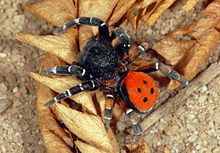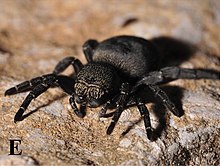Eresus kollari, the ladybird spider,[2] is a spider species in the family Eresidae.[1] It was first described by Walckenaer in 1802, though it was misidentified. It was later correctly described by Rossi in 1846. It is one of the three species into which Eresus cinnaberinus or Eresus niger has been divided.[3] It is thought to be endangered.[citation needed]
| Eresus kollari | |
|---|---|

| |
| Male | |

| |
| Female | |
| Scientific classification | |
| Domain: | Eukaryota |
| Kingdom: | Animalia |
| Phylum: | Arthropoda |
| Subphylum: | Chelicerata |
| Class: | Arachnida |
| Order: | Araneae |
| Infraorder: | Araneomorphae |
| Family: | Eresidae |
| Genus: | Eresus |
| Species: | E. kollari
|
| Binomial name | |
| Eresus kollari Rossi, 1846[1]
| |
Description
editTheir body as most velvet spiders, resemble somewhat those in the jumping spider family. The males have a contrasting color, having a black and red coloration, while the females are completely black. The opisthosoma looks velvety, as their common name would imply.[4]
Colonies
editIn colonies, they burrow up to 10 cm in depth. Which is usually covered in a funnel web. Females may carry lens shape egg sack containing up to 100 eggs. Which she'll carry to a sunny place. The juveniles will stay in the females burrow and feed on her after she dies.[4] They usually form small colonies with up to a couple dozen spiders, but they may reach several hundred or more.[5]
Bite
editAlthough they are small in size, they are able to bite. A bitten finger may cause pain, and cause fever symptoms, an increase heart rate and a headache, that last a few hours. Though it is not medically significant, and after a few days, it is mostly gone.[4]
Habitat
editThey inhabit warm areas, in areas with loose and low vegetation. This spider most often happens in grasslands. Though it has also been found in dry and bright forests. It is found all throughout Europe, except up in the north.[5]
Predators
editSome species of wasp of the family Pompilidae hunt exclusively on the Eresus genus. These wasps enter a burrow and look for the spider, and they paralyse it with strong venom. The female lays the eggs on the spider, and after a few days, the eggs hatch. These larvae eat and kill the spider.[5]
References
edit- ^ a b "Taxon Details: Eresus kollari Rossi, 1846", World Spider Catalog, Natural History Museum Bern, retrieved 2015-10-05
- ^ "BioLib: Biological library".
- ^ Řezáč, M.; Pekár, S. & Johannesen, J. (2008), "Taxonomic review and phylogenetic analysis of central European Eresus species (Araneae: Eresidae)", Zoologica Scripta, 37 (3): 263–287, doi:10.1111/j.1463-6409.2008.00328.x, S2CID 85578392
- ^ a b c "araneae - Eresus kollari". araneae.nmbe.ch. Retrieved 2022-10-16.
- ^ a b c Rozwałka, Robert; Rutkowski, Tomasz; Sienkiewicz, Paweł; Wiśniowski, Bogdan (2019). "The Ladybird Spider Eresus kollari Rossi, 1846 (Araneae: Eresidae) in Poland: Distribution and Current Status of Threat". ResearchGate. Retrieved October 15, 2022.